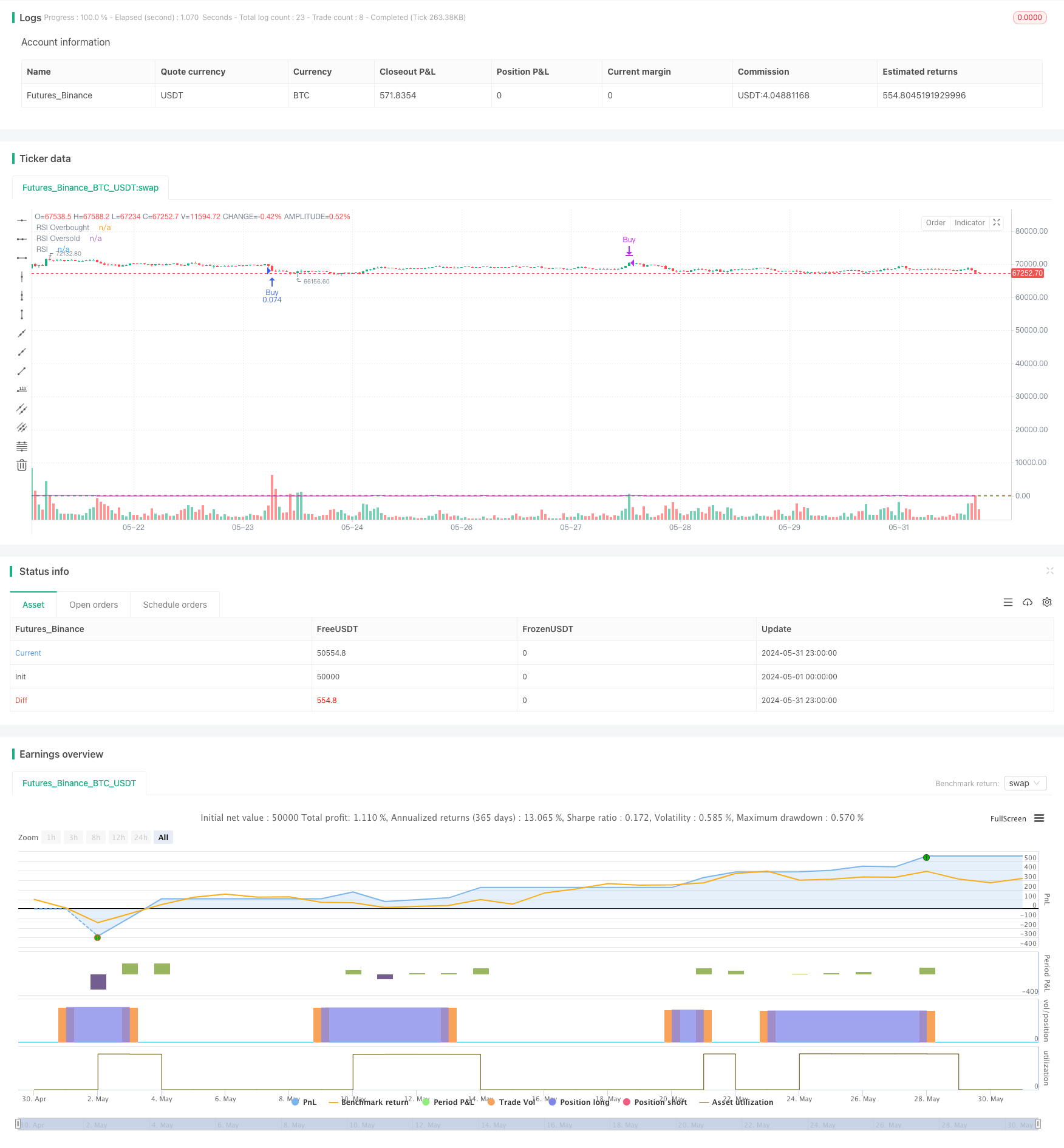
概述
该策略基于相对强弱指数(RSI)技术指标,通过分析资产的超买和超卖状态来进行交易决策。当RSI低于超卖阈值时触发买入信号,当RSI高于超买阈值时触发卖出信号。同时,策略采用了基于百分比的止盈止损机制,通过设定固定的获利百分比和亏损百分比来控制风险和锁定利润。该策略旨在捕捉市场的短期波动,并在趋势反转时及时平仓,以实现稳健的收益。
策略原理
- 计算指定周期的RSI指标值。
- 判断RSI是否低于超卖阈值,若是则触发买入信号,开仓做多。
- 计算开仓价格、止损价格和止盈价格。止损价格为开仓价格乘以(1-止损百分比),止盈价格为开仓价格乘以(1+止盈百分比)。
- 持仓过程中实时监控价格变动:
- 当前价格触及止损价格时,平仓止损。
- 当前价格触及止盈价格时,平仓止盈。
- 当RSI上穿超买阈值时,平仓。
- 若RSI再次低于超卖阈值,则重复步骤2-4,开启下一个交易周期。
优势分析
- 简单易用:该策略基于经典的RSI指标,原理简单,易于理解和实现。
- 趋势适应性强:通过RSI指标捕捉市场超买超卖状态,适应不同的市场趋势。
- 风险可控:采用固定百分比止盈止损,严格控制每笔交易的风险敞口。
- 及时止盈:设定明确的获利目标,当价格达到止盈位时果断平仓,防止利润回吐。
- 减少频繁交易:RSI指标具有一定的滤波功能,可以过滤掉部分噪声信号,减少频繁交易。
风险分析
- 参数敏感性:策略的表现对RSI周期、超买超卖阈值以及止盈止损百分比等参数较为敏感,不同参数可能带来不同结果。
- 振荡市中表现欠佳:在震荡市场环境下,RSI指标可能会频繁触发交易信号,导致过度交易和盈利能力下降。
- 趋势调整风险:在强趋势突然调整的情况下,固定百分比止损可能无法及时保护账户,引发较大回撤。
- 盈亏比风险:固定百分比止盈止损可能导致盈亏比不平衡,从而影响策略的长期稳定性。
优化方向
- 动态调整参数:根据不同市场状态,动态优化RSI周期、超买超卖阈值和止盈止损百分比等参数,提高策略的适应性。
- 引入趋势过滤:结合其他趋势指标,如移动平均线,对RSI信号进行进一步确认,减少振荡市中的虚假信号。
- 优化止盈止损机制:采用更加灵活的止盈止损方法,如移动止损、波动率止损等,提高风险控制能力。
- 加入仓位管理:根据市场波动性和账户风险状况,动态调整每笔交易的仓位大小,平衡收益与风险。
- 结合其他指标:将RSI与其他技术指标如MACD、布林带等结合使用,提高信号的可靠性和稳健性。
总结
RSI基于百分比止盈止损的交易策略通过捕捉市场的超买超卖状态,结合固定百分比止盈止损机制,在趋势反转时及时平仓,以获取稳健收益。该策略原理简单易懂,风险可控,适应性强。但同时也存在参数敏感性、震荡市表现欠佳、趋势调整风险等问题。通过动态调整参数、引入趋势过滤、优化止盈止损机制、加入仓位管理以及结合其他指标等方式,可以进一步提升策略的稳健性和盈利能力,更好地适应多变的市场环境。
策略源码
/*backtest
start: 2024-05-01 00:00:00
end: 2024-05-31 23:59:59
period: 1h
basePeriod: 15m
exchanges: [{"eid":"Futures_Binance","currency":"BTC_USDT"}]
*/
//@version=5
strategy("RSI Strategy with Adjustable TP and SL", overlay=true,
default_qty_type=strategy.percent_of_equity,
default_qty_value=10,
initial_capital=100000,
currency=currency.USD,
commission_type=strategy.commission.percent,
commission_value=0.1)
// RSI settings
rsiPeriod = input.int(14, title="RSI Period")
rsiOverbought = input.int(70, title="RSI Overbought Level", minval=50, maxval=100)
rsiOversold = input.int(30, title="RSI Oversold Level", minval=0, maxval=50)
// Fixed TP and SL settings
takeProfitPct = input.float(20, title="Take Profit Percentage", step=0.1) / 100
stopLossPct = input.float(5, title="Stop Loss Percentage", step=0.1) / 100
// Calculate RSI
rsiValue = ta.rsi(close, rsiPeriod)
// Plot RSI
hline(rsiOverbought, "RSI Overbought", color=color.red)
hline(rsiOversold, "RSI Oversold", color=color.green)
plot(rsiValue, title="RSI", color=color.purple)
// Entry conditions
buyCondition = ta.crossunder(rsiValue, rsiOversold)
sellCondition = ta.crossover(rsiValue, rsiOverbought)
// Calculate stop loss and take profit prices
var float entryPrice = na
var float stopLossLevel = na
var float takeProfitLevel = na
if (buyCondition)
entryPrice := close
stopLossLevel := entryPrice * (1 - stopLossPct)
takeProfitLevel := entryPrice * (1 + takeProfitPct)
strategy.entry("Buy", strategy.long)
// Close positions when TP or SL is hit
if (strategy.position_size > 0)
if (close <= stopLossLevel)
strategy.close("Buy", comment="Stop Loss Hit")
if (close >= takeProfitLevel)
strategy.close("Buy", comment="Take Profit Hit")
// Close positions when RSI crosses above overbought level
if (sellCondition)
strategy.close("Buy", comment="RSI Overbought")
// Optional: Add alerts
alertcondition(buyCondition, title="Buy Alert", message="RSI crossed below oversold level")
alertcondition(sellCondition, title="Sell Alert", message="RSI crossed above overbought level")
相关推荐